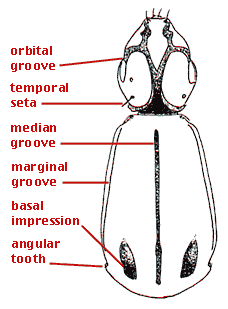Clinidium (Protainoa)
Clinidium extrarium
Ross T. BellCharacteristics
The antennal stylet is long, slender, and acuminate. Tufts are present on antennal segments VI-X. There are one or two temporal seta. The orbital groove is abbreviated posteriorly. The marginal groove of the pronotum is single. Angular and marginal setae are absent. The pronotum is elongate and narrowed anteriorly. The hind angle has a prominent tooth preceded by a pollinose pit. Sutural, parasutural, and intercalary striae are impressed and coarsely punctate. The remaining striae are reduced to rows of fine punctures. The metasternum and abdominal sterna I-III are occupied by a broad medial concavity. The female has enlarged lateral pits on sternum IV. The male's anterior trochanter is dentate. All femora of the male are tuberculate ventrally. The male has an inconspicuous ventral tooth on the anterior femur, and the base of the anterior tarsus is distad to the cleaning organ. The calcars are small, the middle one is longer, more slender, and more acute than the hind one.
References
Bell, R. T. and J. R. Bell. 1985. Rhysodini of the World Part IV. Revisions of Rhyzodiastes and Clinidium, with new species in other genera (Coleoptera: Carabidae or Rhysodidae). Quaestiones Entomologicae 21(1): 1-172.
Bell, R. T. and J. R. Bell. 1995. The Rhysodini (Insecta: Coleoptera: Carabidae) of Cuba. Annals of Carnegie Museum 64(3): 185-195.
About This Page
Ross T. Bell

University of Vermont, Burlington, Vermont, USA
Page copyright © 2000 Ross T. Bell
All Rights Reserved.
- First online 01 March 2000
Citing this page:
Bell, Ross T. 2000. Clinidium (Protainoa). Clinidium extrarium. Version 01 March 2000 (under construction). http://tolweb.org/Clinidium_extrarium/1810/2000.03.01 in The Tree of Life Web Project, http://tolweb.org/








 Go to quick links
Go to quick search
Go to navigation for this section of the ToL site
Go to detailed links for the ToL site
Go to quick links
Go to quick search
Go to navigation for this section of the ToL site
Go to detailed links for the ToL site